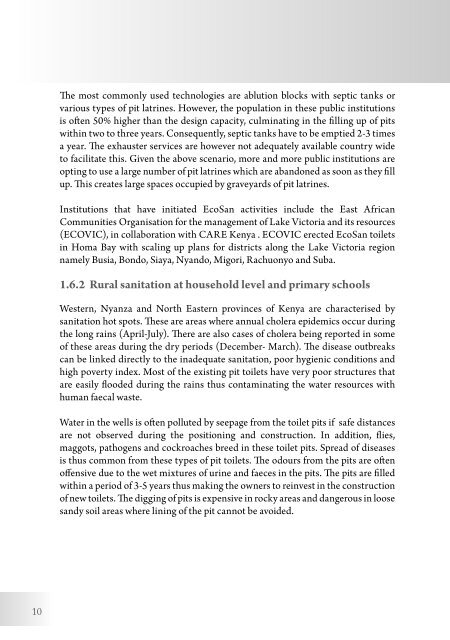Technical Guide to EcoSan Promotion
Technical Guide to EcoSan Promotion
Technical Guide to EcoSan Promotion
You also want an ePaper? Increase the reach of your titles
YUMPU automatically turns print PDFs into web optimized ePapers that Google loves.
The most commonly used technologies are ablution blocks with septic tanks or<br />
various types of pit latrines. However, the population in these public institutions<br />
is often 50% higher than the design capacity, culminating in the filling up of pits<br />
within two <strong>to</strong> three years. Consequently, septic tanks have <strong>to</strong> be emptied 2-3 times<br />
a year. The exhauster services are however not adequately available country wide<br />
<strong>to</strong> facilitate this. Given the above scenario, more and more public institutions are<br />
opting <strong>to</strong> use a large number of pit latrines which are abandoned as soon as they fill<br />
up. This creates large spaces occupied by graveyards of pit latrines.<br />
Institutions that have initiated <strong>EcoSan</strong> activities include the East African<br />
Communities Organisation for the management of Lake Vic<strong>to</strong>ria and its resources<br />
(ECOVIC), in collaboration with CARE Kenya . ECOVIC erected <strong>EcoSan</strong> <strong>to</strong>ilets<br />
in Homa Bay with scaling up plans for districts along the Lake Vic<strong>to</strong>ria region<br />
namely Busia, Bondo, Siaya, Nyando, Migori, Rachuonyo and Suba.<br />
1.6.2 Rural sanitation at household level and primary schools<br />
Western, Nyanza and North Eastern provinces of Kenya are characterised by<br />
sanitation hot spots. These are areas where annual cholera epidemics occur during<br />
the long rains (April-July). There are also cases of cholera being reported in some<br />
of these areas during the dry periods (December- March). The disease outbreaks<br />
can be linked directly <strong>to</strong> the inadequate sanitation, poor hygienic conditions and<br />
high poverty index. Most of the existing pit <strong>to</strong>ilets have very poor structures that<br />
are easily flooded during the rains thus contaminating the water resources with<br />
human faecal waste.<br />
Water in the wells is often polluted by seepage from the <strong>to</strong>ilet pits if safe distances<br />
are not observed during the positioning and construction. In addition, flies,<br />
maggots, pathogens and cockroaches breed in these <strong>to</strong>ilet pits. Spread of diseases<br />
is thus common from these types of pit <strong>to</strong>ilets. The odours from the pits are often<br />
offensive due <strong>to</strong> the wet mixtures of urine and faeces in the pits. The pits are filled<br />
within a period of 3-5 years thus making the owners <strong>to</strong> reinvest in the construction<br />
of new <strong>to</strong>ilets. The digging of pits is expensive in rocky areas and dangerous in loose<br />
sandy soil areas where lining of the pit cannot be avoided.<br />
10

















